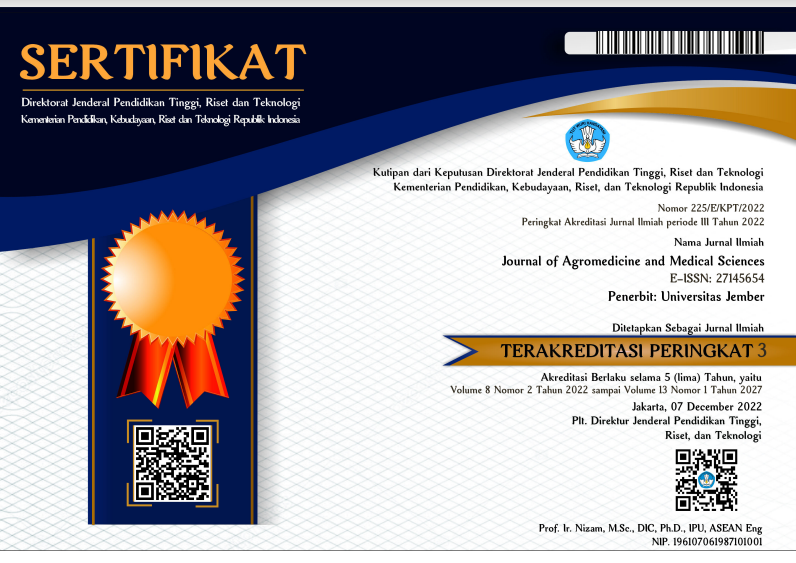Impact of the User-Friendliness of BalitaGrow+ on Compliance with Children's Daily Nutrition Column Completing
DOI:
https://doi.org/10.19184/ams.v10i3.46663Abstract
Abstract
Nutritional imbalances can lead to malnutrition which can affect children's physical and cognitive growth and development. Advances in science and technology have created opportunities for innovation in the form of health applications to help monitor children's growth and development, nutritional status, and children's daily nutritional intake. The factor that influences the intention to use technology is the ease of use. This indicates that the easier the application is to use, the higher a person's interest and compliance will be in using the application regularly. This research aims to determine the effect of ease of use of the BalitaGrow+ application on compliance with filling in the daily nutrition column for children in Rambigundam Village, Jember. This research was an analytical observational research with a cross sectional approach with a sample size of 35 people who meet the criteria. Data analysis used univariate tests and bivariate used the Spearman Rank correlation test. The results obtained from 35 respondents showed that 34 people (97.1%) found it easy to use the BalitaGrow+ application and 31 people (88.6%) had good compliance in filling in the child's daily nutrition column in the application. The results of statistical analysis showed a significance value of p value >0.05 (0.726). So it can be concluded that there was an insignificant influence between the ease of use of the BalitaGrow+ application on compliance with filling in the daily nutrition column for children in Rambigundam Village, Jember. It is suggested to increase the sample size and investigate other influenced factors for future study.
Keywords: health application, ease of use, compliance of filling, children’s nutrition
Downloads
References
Barutçu, S., Barutçu, E., & Adigüzel, D. Ü. (2018). A Technology Acceptance Analysis for mHealth Apps: The Case of Turkey. Balkan and Near Eastern Journal of Social Sciences, 04(04), 4.
Bertalina, B., & Purnama, P. (2016). Hubungan Lama Sakit, Pengetahuan, Motivasi Pasien dan Dukungan Keluarga dengan Kepatuhan Diet Pasien Diabetes Mellitus. Jurnal Kesehatan, 7(2), 329–340. https://doi.org/10.26630/jk.v7i2.211
Bol, N., Helberger, N., & Weert, J. C. M. (2018). Differences in mobile health app use: A source of new digital inequalities? Information Society, 34(3), 183–193. https://doi.org/10.1080/01972243.2018.1438550
Buchholz, K. (2020). Where Health App Usage Is Most Common. https://www.statista.com/chart/23161/health-app-usage-country-comparison/
Chamara, C. V., Setyawan, D., & Yulandari, A. (2022). Pembentukan Niat Menggunakan Aplikasi Kesehatan Good Doctor Pada. Jurnal Bisnis Dan Kewirausahaan, 15(April), 13–23.
Davis, F. D. (1989). Perceived Usefulness, Perceived Ease of Use, and User Acceptance of Information Technology. MIS Quarterly, 13(3), 319–340. https://doi.org/10.5962/bhl.title.33621
Haryanto, D., Zainuddin, & Topan, P. A. (2023). Pengaruh Tingkat Pengetahuan dan Motivasi Perawat terhadap Penggunaan Aplikasi SIMRS di Rumah Sakit Umum Daerah Sumbawa. Jurnal Pendidikan, Bahasa, Sastra, Seni, Budaya, Dan Sosial Humaniora, 1(1), 97–111.
Hasanah, M. S., Lubis, A. D., & Syahleman, R. (2021). Hubungan Tingkat Pengetahuan Ibu Tentang Imunisasi Dasar Terhadap Kepatuhan Pemberian Imunisasi Dasar Pada Bayi. Jurnal Borneo Cendekia, 5(1), 53–63. https://doi.org/10.54411/jbc.v5i1.222
Hina, S. B. G. J., & Picauly, I. (2021). Hubungan Faktor Asupan Gizi, Riwayat Penyakit Infeksi Dan Riwayat ASI Eksklusif Dengan Kejadian Stunting Di Kabupaten Kupang. Jurnal Pangan Gizi Dan Kesehatan, 10(2), 61–70. https://doi.org/10.51556/ejpazih.v10i2.155
Indriyati, I., Laksmi P, K. W., & Ariwangsa, I. O. (2021). Pengaruh Minat, Persepsi Kebermanfaatan, Dan Kemudahan Penggunaan E-Filling Terhadap Kepatuhan Wajib Pajak Orang Pribadi Di Kabupaten Manggarai. Jurnal Ilmiah Akuntansi Dan Bisnis, 6(1), 24–31. https://doi.org/10.38043/jiab.v6i1.3031
Kemenkes. (2022). Hasil Survei Status Gizi Indonesia (SSGI) 2022. 1–7.
Kesari, A., & Noel, J. Y. (2023). Nutritional Assesment. StatPearls Publishing. https://www.ncbi.nlm.nih.gov/books/NBK580496/
Kustiawan, T. C., Nadhiroh, S. R., Ramli, R., & Butryee, C. (2022). Use of Mobile App To Monitoring Growth Outcome of Children : A Systematic Literature Review. Digital Health, 8(1–10), 1–10. https://doi.org/10.1177/20552076221138641
Kwee, V., Istijanto, I., & Widjojo, H. (2022). Understanding the Determinants of m-Health Adoption in Indonesia. Jurnal Manajemen Teori Dan Terapan | Journal of Theory and Applied Management, 15(3), 408–422. https://doi.org/10.20473/jmtt.v15i3.40142
Mahendra, M. B., & Oktaviani, R. M. (2022). Determinan Niat Wajib Pajak Perspektif Theory of Planned Behavior. Jurnal Ilmiah Komputerisasi Akuntansi, 15(1), 231–240. https://doi.org/10.51903/kompak.v15i1.644
Mayasari, A. C., & Ngakili, O. R. (2017). Analisis Faktor Sikap Ibu, Dukungan Keluarga, Tingkat Pengetahuan, Dan Jenis Pekerjaan Ibu Dengan Imunisasi Dasar Lengkap. PROSIDING HEFA, 1.
Noorhasanah, E., & Tauhidah, N. I. (2021). Hubungan Pola Asuh Ibu Dengan Kejadian Stunting Anak Usia 12-59 Bulan. Jurnal Ilmu Keperawatan Anak, 4(1), 37–42. https://doi.org/10.32584/jika.v4i1.959
Nurlifa, A., Kusumadewi, S., & Kariyam. (2014). Analisis Pengaruh User Interface Terhadap Kemudahan Penggunaan Sistem Pendukung Keputusan Seorang Dokter. Prosiding SNATIF, 333–340.
Octavius, G. S., & Antonio, F. (2021). Antecedents of Intention to Adopt Mobile Health (mHealth) Application and Its Impact on Intention to Recommend: An Evidence from Indonesian Customers. International Journal of Telemedicine and Applications, 2021. https://doi.org/10.1155/2021/6698627
Pratama, B. B. B. (2022). Jember Target 2022 Stunting Turun Jadi 10 Persen. https://tadatodays.com/detail/jember-target-2022-stunting-turun-jadi-10-persen
Pratasis, N. N., Malonda, N. S. H., & Kapantow, N. H. (2018). Hubungan Antara Karakteristik Ibu Dengan Status Gizi Pada Balita Di Desa Ongkaw Kecamatan Sinonsayang Kabupaten Minahasa Selatan. 1–9.
Pratiwi, I. G., & Restanty, D. A. (2018). Penerapan Aplikasi Berbasis Android “Status Gizi Balita Terhadap Pengetahuan Ibu Dalam Pemantauan Status Gizi Anak Usia 12-24 Bulan.†JKAKJ, 2(1), 8–14.
Purnamasari, E. F., & Meutia, R. (2023). Hubungan Sikap dan Motivasi Terhadap Kepatuhan Minum Obat Pada Pasien Penderita Hipertensi Di Rumah Sakit Advent Medan. Jambura Journal of Health Science and Research, 5(2), 541–549.
Rahmawati, R. N., & Narsa, I. M. (2019). Actual Usage Penggunaan E-Learning Dengan Technology Acceptance Model (TAM). Jurnal Inovasi Teknologi Pendidikan, 6(2), 127–136. https://doi.org/10.21831/jitp.v6i2.26232
Risti, K. N., & Isnaeni, F. N. (2017). Hubungan Motivasi Diri Dan Pengetahuan Gizi Terhadap Kepatuhan Diet DM Pada Pasien Diabetes Mellitus Tipe II Rawat Jalan Di RSUD Karanganyar. Jurnal Kesehatan, 10(2), 94–103.
Rosa, E. M. (2018). Kepatuhan (Compliance). https://mars.umy.ac.id/kepatuhan-compliance/
Salsabila, S., Noviyanti, R. D., & Kusudaryati, D. P. D. (2022). Hubungan Tingkat Pendidikan Ibu dan Pola Asuh Orang Tua dengan Kejadian Stunting pada Balita Usia 12-36 Bulan di Wilayah Puskesmas Sangkrah. PROFESI (Profesional Islam): Media Publikasi Penelitian, 19(2), 143–151.
Saputra, D., & Kania, R. (2022). Designing User Interface of a Mobile Learning Application by Using a Design Thinking Approach: A Case Study on UNI Course. Journal of Marketing Innovation (JMI), 2(2), 102–119. https://doi.org/10.35313/jmi.v2i2.36
Setianingsih, A., Dulakhir, D., & Yusup, N. S. (2021). Hubungan Sikap, Motivasi dan Dukungan Tokoh Masyarakat Terhadap Perilaku Kepatuhan Ibu Dalam Membawa Balita Ke Posyandu. Jurnal Ilmiah Kesehatan, 13(2), 165–173. https://doi.org/10.37012/jik.v13i2.435
Shaputri, W. E., & Dewanto, N. E. (2023). Hubungan Antara Pendidikan Ibu Dengan Status Gizi Anak Usia 1 Tahun 6 Bulan Sampai 2 Tahun Di RS Sumber Waras. 15.
Siswati, T., Widyawati, H. E., Pertiwi, Q. C., Afianti, W. D., Rialihanto, M. P., Tjaronosari, & Nurhidayat. (2023). Pelatihan Penggunaan Aplikasi Android untuk Monitoring Pertumbuhan dan Perkembangan Balita. Jurnal Inovasi Dan Pengabdian Masyarakat Indonesia (JIPMI), 2(2), 46–50.
Suroso, J. S., & Sukmoro, T. C. (2021). Factors Affecting Behavior of The Use of Healthcare Mobile Application Technology In Indonesian Society. Journal of Theoretical and Applied Information Technology, 99(15), 3923–3934.
Terencia, A., Nugroho, D. C. A., Wicaksono, H., & Ida, A. (2023). Pengaruh Usia Terhadap Penggunaan Telekonsultasi Sebagai Bagian Dari Penerimaan Telehealth Oleh Masyarakat di D.I Yogyakarta. Seminar Nasional Riset Kedokteran (SENSORIK) 2023, 73–79.
Venkatesh, V., Thong, J. Y. L., & Xu, X. (2012). Customer Acceptance and Use of Information Technology : Extending the Unified Theory of Acceptance and Use of Technology. MIS Quarterly, 36(1), 157–178. https://doi.org/https://doi.org/10.2307/41410412
Wang, C., & Qi, H. (2021). Influencing Factors of Acceptance and Use Behavior of Mobile Health Application Users: Systematic Review. Healthcare (Switzerland), 9(3). https://doi.org/10.3390/healthcare9030357
Wardana, E., & Sihite, J. (2021). The Influence Of Ease Of Use, Usefulness, Privacy Risk, and Government Support Towards Young Adult’s Usage Intention On mHealth During Covid-19 In Jakarta (Case Study On Halodoc). International Humanities and Applied Science Journal, 4(2), 64-74.
World Health Organization. (2018). Reducing stunting in children: equity considerations for achieving the Global Nutrition Targets 2025.
World Health Organization. (2023). Malnutrition. https://www.who.int/news-room/fact-sheets/detail/malnutrition
Wu, P., Zhang, R., Zhu, X., & Liu, M. (2022). Factors Influencing Continued Usage Behavior on Mobile Health Applications. Healthcare, 10(208). https://doi.org/https://doi.org/10.3390/ healthcare10020208
Yulaikah, N., & Artanti, Y. (2022). Faktor-Faktor yang Mempengaruhi Keputusan Penggunaan Telemedicine saat Pandemi COVID-19. Business Innovation and Entrepreneurship Journal, 4(1), 1–11. https://doi.org/10.35899/biej.v4i1.351
Downloads
Published
Issue
Section
License
Copyright (c) 2024 Ranny Tandria Pradewi, Ancah C N Marchianti, Muhammad Ali Shodikin, Dwita Aryadina Rachmawati, Irawan Fajar Kusuma, Yohanes Sudarmanto

This work is licensed under a Creative Commons Attribution-ShareAlike 4.0 International License.























